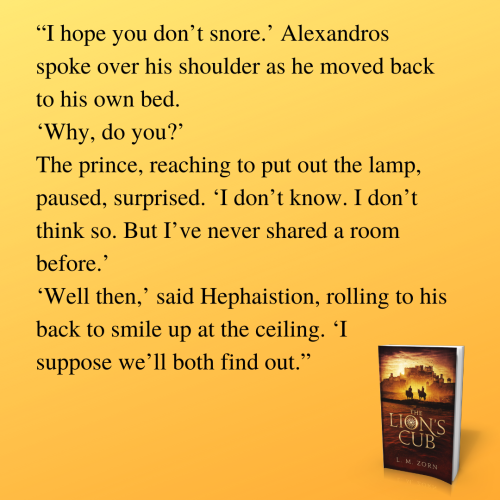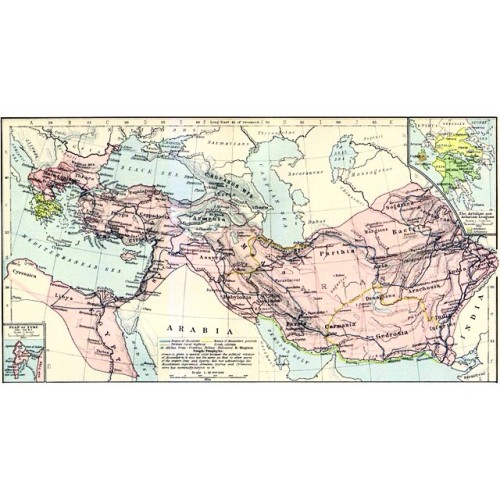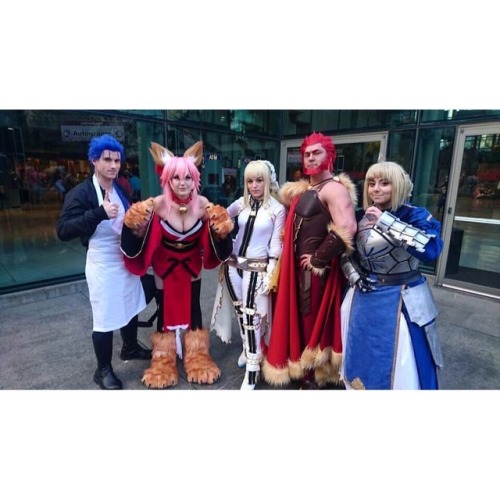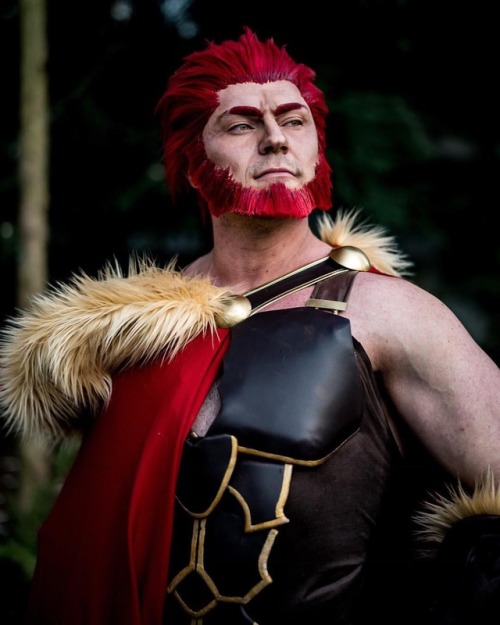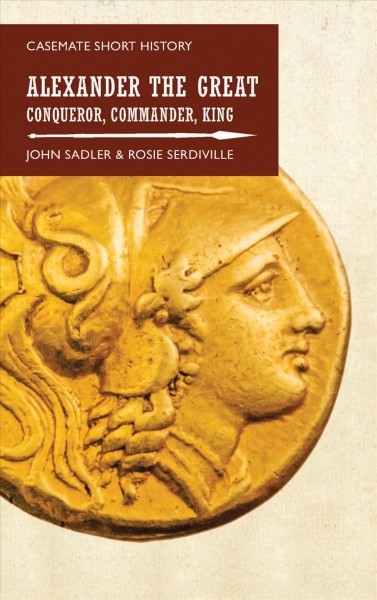#alexanderthegreat
“The men are testing me as much as I’m testing them. They want to see if I’m softer than my father. I have to show them I’m not.’
Hephaistion shot him a scathing look. ‘Most of them have known you since you were a boy. Where in all Hades would they have got the idea that you’re soft?”
The Lion’s Cub by L M Zorn
Book 1 of the Philalexandros Chronicles
GR:https://www.goodreads.com/book/show/56885918-the-lion-s-cub
Preorder:https://books2read.com/u/m2M8vk
Post link
“You could stay with your father and raise horses. There’s honour in it.’
‘I could,’ Hephaistion agreed. ‘And I will, when all this is done. But right now that would mean leaving you to your own good sense, and from what I can tell that’s thin on the ground.”
Post link
“I hope you don’t snore.’ Alexandros spoke over his shoulder as he moved back to his own bed.
‘Why, do you?’
The prince, reaching to put out the lamp, paused, surprised. ‘I don’t know. I don’t think so. But I’ve never shared a room before.’
‘Well then,’ said Hephaistion, rolling to his back to smile up at the ceiling. ‘I suppose we’ll both find out.”
GR: The Lion’s Cub by L.M. Zorn https://www.goodreads.com/book/show/56885918-the-lion-s-cub
Preorder:https://books2read.com/u/m2M8vk
Post link
Map of the Macedonian Empire by Alexander the Great, Armenia unconquered.Historical Atlas by William R. Shepherd, 1911
During the great conquests of the young Macedonian Emperor Alexander the Great, entire Asia was subdued. Except Armenia. According to many sources, Alexander the Great, nor his successor were able to conquer Armenia.
The Cambridge University historian W. Tran on Alexander’s conquests noted: Alexander the Great appointed Mithrinés as the satrap of Armenia and sent him there, but the country was never conquered.” Later he continued: “The successors of Alexander came quickly to the conclusion that it was wiser to give up any hope of having a satrap in Armenia, since the country already had become independent and was ruled by a dynasty founded by Orontés.
The Roman historian Pompeius Trogus (recounted by Marcus Junianius) confirms as he mentions that: “Neither Alexander, who subdued all Asia, nor any of his successors or posterity had been able to meddle with the people of Greater and Lesser Armenia”. Justin, Epitome of Pompeius Trogus (Roman Historian of the 1st century BC), Book XXXVIII
Post link
Ever wondered where #AlexanderTheGreat laid foot? I did. So I travelled to #Pella where he was born in #Greece ( #Macedonia region of #Hellas ) #Instagreece #AncientRuins #Greece #Archeological #History #Beauty
Post link
One of my favorite sites in Greece : #Pella ( birthplace of #AlexanderTheGreat in #Macedonia region of #Greece ) #AncientRuins #Ancient #Art #History #archeology #Instagreece #Makethonia (Photo taken at the #Archeological Museum of Pella in Greece )
Post link
Found another simple shot from Sakuracon thanks to a friend, and all I can think about is how good we look while just being huge dorks. Even though very few of our outfits go together, I always enjoy having a group of people from the same series just hanging out and being friends. Getting to make memories from your bond of a series and building upon new and old friendships is a big part of cosplay for me. The older I get the more I welcome those bonds because it builds upon a creative passion we all love to share!
__________________________________
Saber: @mariahmallad
Rider: Myself
Berserker Tamamo: @veronicalunalu
Bride Nero: @nicoletters
Cu: @weebking
_______________________________________________________ #fatezero #fate #fatecosplay #fatestaynight #fategrandorder #fatego #fateseries #fgo #fatezerocosplay #cosplay #cosplayer #sakuracon2018 #sakuracon #iskander #alexanderthegreat #saber #kingarthur #rider #ridercosplay #momokun #lancer #lancercosplay #cuchulainn #bridenero #neroclaudius #nerocosplay#berserkertamamo #tamamocat #tamamocosplay (at Sakura-Con)
Post link
Another Iskander photo! This was a pretty awesome and unexpected photo that I got back really quickly! Has zero editing whatsoever too and I’m incredibly grateful that @veronicalunalu helped bring out the conqueror in me by helping putting it together and making me look extra fierce.
__________________________________
: @thesleepymuse
Rider: Myself
__________________________________ #fatezero #fate #fatecosplay #fatestaynight #fategrandorder #fatego #fateseries #fgo #fatezerocosplay #cosplay #cosplayer #sakuracon2018 #sakuracon #iskander #alexanderthegreat #rider #canthidemyrazorburnthough (at Washington State Convention Center)
Post link
A Dutch aquamanile (ca. 1400) – a vessel for pouring out water to wash your hands – depicting Aristotle and Phyllis. This fable about the ancient philosopher was popular in the middle ages. The story went that Phyllis had seduced and distracted Alexander the Great, Aristotle’s pupil. In order to teach his student a lesson, Aristotle allowed Phyllis to seduce and publicly humiliate him so that Alexander could see the dangers of allowing himself to be controlled by a woman.
Post link
Mosaic of the birth of Achilles , Nea Paphos, Cyprus, 5th century.
The mosaic was found in 1970-1971 during the Polish excavations at Nea Paphos on the south coast of Cyprus. It is located in the central reception hall of a late Roman palace; except for a large lacuna in the center and a smaller one along the bottom, it is in good condition.
The subject is the birth of Achilles. In the center Thetis reclines majestically on a couch. A nurse labeled Anatrophe (“Education”) kneels at the left, holding out the newborn babe. Under the couch is a basin of water, in which he will be bathed, and at the left side of the scene a woman called Ambrosia (misspelled “Anbrosia”) approaches with a pitcher. Next to Thetis is the somewhat smaller figure of Peleus, the father, enthroned and holding a scepter. Behind him and further to the right are the three Moirai, or Fates: Clotho, holding the spindle and distaff with the thread of life; Lachesis, with the tablet in which is inscribed Achilles’ life; and Atropos, holding the scroll of eternity. All of the figures look outward at the beholder, even the little Achilles. Their gazes are severe, almost expressionless. The drapery is angular and simplified. Spatial relationships are suppressed, and the figures seem to float against the neutral background, their feet hovering above the undulating groundline. This Late Antique style is also seen in a mosaic from Soueidie, near Ba'albek, where the subject of one scene is the birth of Alexander. Archaeological evidence points to a date in the early fifth century for this mosaic.
This is the fullest surviving version of the birth of Achilles; Peleus, the Fates, and the woman Ambrosia are not found elsewhere, although the central group of Thetis, nurse, and Achilles is similar to the birth scene in other pieces. The washing of the newborn child is common in other birth scenes (as in the Soueidie Alexander mosaic) and was adopted with few changes for the Christian nativity. The presence of the woman Ambrosia may allude to an old story that held that Thetis anointed Achilles with ambrosia to make him immortal. The Fates are in attendance because a new life is beginning; they also appear in a birth scene on a recently discovered child’s sarcophagus in Sicily (Museo Nazionale Agrigento). Their presence also reminds us of the brevity of Achilles’ life and of his mother’s vain efforts to defy his fate.
Post link
“This concise history gives an overview of Alexander’s life from a military standpoint, from his early military exploits to the creation of his empire and the legacy left after his premature death.”
AlexanderTheGreat
Post link



